Featured Topic: Evolution of Sompo Holdings Group’s Climate Actions
Climate change is aggravating natural disasters and causing a spate of damage. In response, the Sompo Holdings Group is taking on new challenges in our P&C insurance operations, our core business, to ensure our customers feel safe by providing prompt insurance payments. Our Strategic Business Design Department, which uses digital and other advanced technologies to tackle social issues, is working to develop services that help strengthen local resilience.
We invited Mr. Hideto Kawakita, CEO of the International Institute for Human, Organization and the Earth (IIHOE), and publisher of the Socio Management Review, who has been providing third-party comments for our CSR Communication Reports every year since 2001, to discuss our Group’s efforts to address climate change and future evolution towards the creation of new value in the form of a “theme park for security, health, and wellbeing.” (Date of dialogue: July 1, 2019)
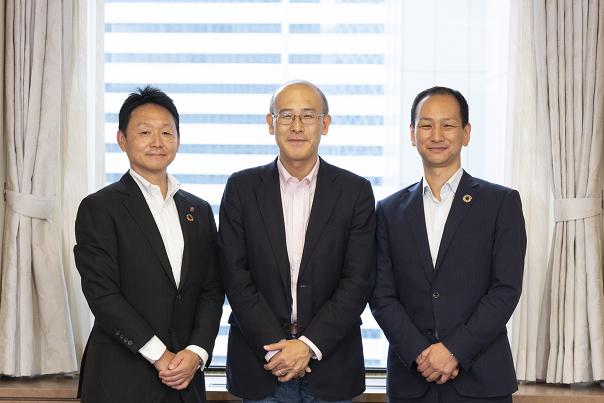
Masumi Nakada
General Manager of Claims Administration Department, Sompo Japan Insurance Inc.
Hideto Kawakita
CEO, International Institute for Human, Organization and the Earth (IIHOE)
Publisher, Socio Management Review
Akihiro Kimura
General Manager of Strategic Business Design Department, Sompo Japan Insurance Inc.
(The affiliation, titles, etc. in a sentence are as at the time of dialogue)
Response to Natural Disasters in FY2018 and Use of Digital Technology by Insurance Claims Department
Nakada: The threat of natural disasters is increasing each year. In fiscal year 2018, Japan suffered several major disasters including the Osaka and Hokkaido Eastern Iburi earthquakes, torrential rain in western Japan, and Typhoons Jebi (No.21) and Trami (No.24).
The economic damage from these disasters was enormous. The insurance industry, for example, paid out more than 1.6 trillion yen. Sompo Japan Nipponkoa responded to customers by setting up roughly 20 disaster response headquarters and offices in various parts of Japan and promptly dispatching support staff from across the country.
During 2018, we were reminded of an issue of too many accident reports being sent to our response center after a disaster. We have started to accept accident reports via LINE, a social networking service (SNS) app, and when a disaster strikes, we send out LINE messages to customers in the affected areas, detailing how to report accidents via the app and other useful information. In the future, we will improve the quality and efficiency of our accident response services, including by automatically inputting accident report information using robotic process automation (RPA) and responding in areas not affected by disasters.
Kawakita: Do you sense that operations have become more efficient? For example, does the use of technology such as RPA expedite insurance payments?
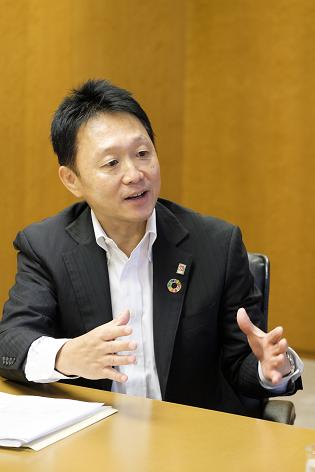
Nakada: In addition to RPA, we have also streamlined data entry tasks by automatically converting voice to text during telephone calls. Our other initiatives include developing a system that automatically determines the extent of responsibility for automobile accidents by using AI to analyze drive recorder video data. Customers often struggle to explain the circumstances surrounding accidents and we hope this system will eliminate some of the anxiety experienced by customers immediately after an accident.
Training employees who are in direct contact with customers involved in accidents is, first and foremost, a key priority for insurance companies. We have developed our own code of conduct, SC Credo*, which forms the basis for making decisions in response to customers’ inquires. Moreover, the insurance claims department is predominantly staffed by female employees who interact with customers on a daily basis and so it is important for us to create an environment in which women can demonstrate their potential.
Kawakita: The insurance claims department is one of the most important points of contact with customers. I am keen to see services enhanced through personnel training and the use of technology. You already use AI to analyze drive recorder video, but I think, in cooperation with automobile manufacturers and parts makers, you can also evolve the use of AI into a system to analyze the cause of accidents and prevent accidents.
- Targeting insurance claims department staff, the SC Credo contains guiding principles for everyday judgment, decision-making, and action. It highlights the importance of putting customers as the first priority and providing sincere service to every single customer.
Developing New Business to Contribute to Climate Change Adaptation
Kimura: Our Strategic Business Design Department is working to create business that uses technology to address various social issues. However, natural disasters are a social issue that current technology cannot prevent.
The global natural environment has changed dramatically and data from the past 30 years is no longer relevant to today’s society. The major disasters experienced in recent years indicate a new normal that is intensifying damage, rendering the experience we have accumulated as an insurance company useless. In an effort to build the sustainable society promoted also by the SDGs, we have teamed up with a US based startup company to prevent damage from such major disasters using technology and started to work on AI-driven disaster preparedness and resilience initiatives.
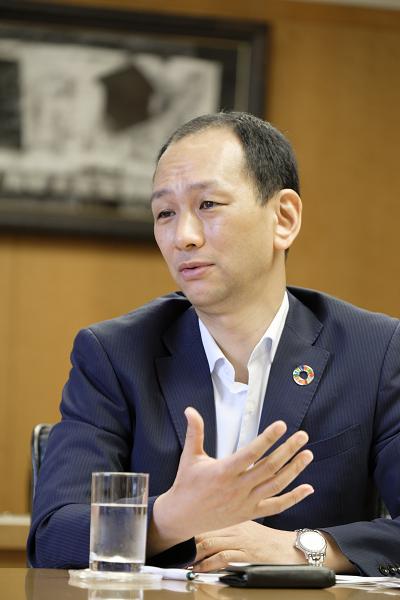
We were introduced to a startup, One Concern, through our Digital Lab in Silicon Valley and asked whether their technology could be used in Japan. I immediately headed to the States to find out more and visited San Francisco and Seattle, two cities which have adopted their technology. I was surprised to discover that earthquake and flooding simulations that were previously expensive and took days to create, could be generated easily and in detail in just a few minutes. I believe that the use of this technology in Japan will have a positive impact on disaster preparedness measures.
Their system uses AI and various types of data on weather, buildings and so on that relates to regional disaster preparedness to provide a service that accurately predicts damage before, during, and after disasters, such as flooding and earthquakes, and enables the extent of damage to be grasped in real time by block (sections of cities). Local governments can use the results of such predictions to organize participation-style training for residents to review evacuation routes and learn how to provide support to the elderly. After a disaster strikes, this system collects actual data and predicts damage using AI, speeding up rescue and recovery work. We are currently conducting tests with Kumamoto City in collaboration with Weathernews, a company that provides weather information. In the future, we hope to contribute to the strengthening of resilience in communities so that no one is left behind, by expanding the service to many local governments and companies.
At the time of the 2011 earthquake and tsunami, I was in Sendai, one of the cities affected by the disaster. I experienced both being a victim and running the disaster response headquarters in Tohoku. Conventional insurance is only useful to customers when an accident occurs, and after my experience in 2011 I felt the need to minimize damage before a disaster strikes. Now, as the Sompo Holdings Group works to realize a “theme park for security, health, and wellbeing,” we have reached a point in which we can use digital technology to take on this new challenge.
Kawakita: From this fiscal year, Shizuoka City will introduce a system, in collaboration with a non-profit organization, to commend welfare facilities for voluntarily evacuating promptly even when a disaster ultimately does not materialize after a weather warning is issued. Getting into the habit of evacuating, even if voluntary evacuation proves to be unnecessary, is one way to encourage prompt action in an actual disaster.
I hope that you will also work with local governments on Japan’s Pacific coast to develop and introduce a disaster preparedness system with One Concern.
Kimura: Disaster Prevention/Reduction Insurance, a product we have launched in collaboration with the Japan Association of City Mayors and the National Association of Towns and Villages that supports early evacuation initiatives by local governments, is the first insurance product anywhere in the world to pay out insurance money before a disaster is triggered.
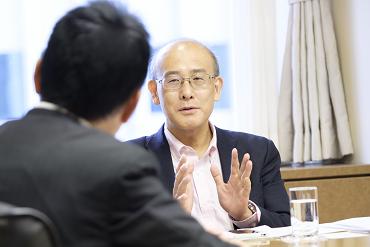
Kawakita: I believe this is also called “insurance to support unnecessary disaster response.” I expect you to expand this product not only to local governments but also to welfare and other operators.
As the population both ages and declines, communities are facing a variety of issues, not just disaster preparedness. There is however a limit on what the governments and businesses can do, and it is vital to increase more community-based activities. At present, I do not believe that there is insurance that covers activities and projects organized by local residents such as shopping assistance and community transportation. While it is acceptable to offer insurance for such activities via municipalities, I hope that you will provide insurance products directly to organizations responsible for regional development and thus promote local sustainability.
To cover such regional and local initiatives, I expect you to develop insurance products that encourage spending on risk control, for example, by paying an accident-free bonus, covering costs for disaster preparedness, and supporting improvements to asset value.
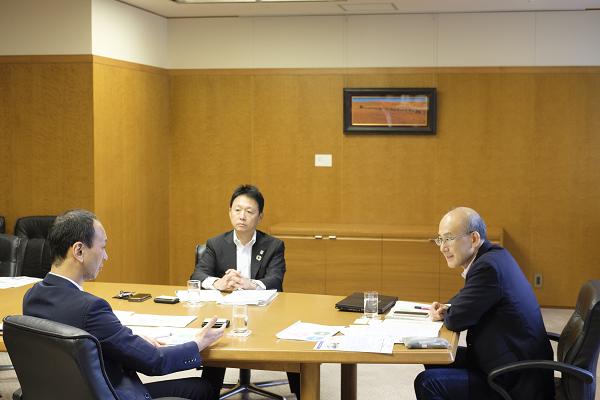
Evolution of Disaster Preparedness for Creating New Value
Kawakita: Society expects P&C insurance companies to be speedy in their initial response after a disaster and to offer a full range of products and services. Have you changed the way in which you obtain precise information in a short period of time?
Kimura: In terms of risk control, the system we are currently developing will enable us to predict the kind of damage that will affect each region. Going forward, we will consider developing products linked to this system to prevent damage occurring.
Kawakita: That is an excellent idea. As things stand, Japanese homes will deteriorate causing damage to spread and I would really like to find a way to stop this somehow. I hope that insurance products to encourage risk control such as the ones I just mentioned will also be developed to expand their coverage to individuals. Thank you for giving me this opportunity to talk with you today and learn about your initiatives.